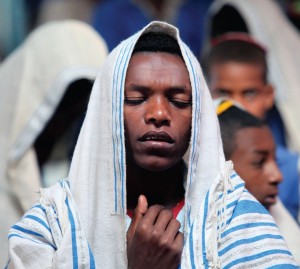 Nearly 30 years ago, the world was forced to reconsider what it means to “look Jewish” when, through Operation Moses and, six years later, Operation Solomon, more than 22,000 Ethiopian Jews were airlifted to their new home in Israel.
Nearly 30 years ago, the world was forced to reconsider what it means to “look Jewish” when, through Operation Moses and, six years later, Operation Solomon, more than 22,000 Ethiopian Jews were airlifted to their new home in Israel.
The United Jewish Federation of Tidewater, in partnership with the Jewish Agency for Israel, will present a photographic retrospective documenting the process of Ethiopian Jews taking the final steps along their journey home. It Takes a Village: From Gondar to Jerusalem The Remarkable Journey of Ethiopia’s Jews: A Photographic Retrospective consists of 34 large-scale photographs.
The photographs give viewers a peek inside the gritty conditions in Ethiopia and capture the arresting moments of joy and rescue as Ethiopian Jews first set foot in Israel and kiss Israeli soil. This high-impact exhibit will be on display in the Leon Family Art Gallery on the second floor of the Sandler Family Campus, Thursday, Sept. 27 through Wednesday, Oct. 10. This is the only stop this traveling exhibit is scheduled to make in the region. On Sunday, Oct. 7, students from area synagogues’ Sunday school classes will visit the exhibit and hear first-hand accounts of this modern-day Exodus which is still going on.
As a child, Maly Gaday Jackson was among the thousands who escaped Ethiopia. Her family arrived in Israel when she was seven years old. Today, she lives with her family in Tidewater and serves as assistant teacher at the Strelitz Early Childhood Center. Students will hear Jackson recount how she left everything she’d known to walk for days, fight severe sickness, and lose family and friends on the journey. She will also address some of the challenges she faced after arriving in Israel.
“In Israel, as a child, I couldn’t understand why the other kids in class would not say, ‘She’s Jewish,’ but would point at me and say, ‘she’s black.’ It was very difficult for me,” Jackson says. “I want the children to know, just like G-d created animals of all different kinds, he created people the same—in all different shapes and colors. And it’s the same way in Judaism—it doesn’t matter if we have different colored skin, or speak different languages, or come from other places—we are all Jews.”
Jackson’s story will be supplemented with the recollections of Carolyn Amacher and Mark Lipton, two community members who were living in Israel in December 1984 when the Ethiopian Jews arrived. They were participants in the year-long WUJS Institute in Arad, where post-college Jews from around the world converged for a gap year of intensive Hebrew and Judaic learning and were placed in jobs in their professional fields. Their dormitory was partially converted to an absorption center literally in the middle of the night to host the newly arrived Ethiopian refugees of Operation Moses.
Lipton says the Sunday School students will come away with a greater sense of the importance of the State of Israel. “The Ethiopian Jews had no place to go, but the State of Israel rescued them from a land that had always called them Outsiders (Falasha),” he says. “Without Zionism, the belief in the return of Jews to Israel as a place of refuge from discrimination and persecution, there would be no place to go for Jews like the Jews of Ethiopia (or the former Soviet Union, Romania, Argentina, etc.).”
Amacher, UJFT’s community development specialist, recalls being awakened in the middle of the night to help the newly-arrived Ethiopian families into their new dwelling, apartments where they quickly discovered modern utilities like refrigeration, gas stoves, electrical lamps, and batteryoperated radios.
She notes that for American Jewish children, being Jewish is easy. She contrasts that to what Jackson and her family went through “Maly and her family were forced to do things they didn’t think possible so that they could remain Jewish. I want students to see just how compelling that faith is that got them through that journey.”
Parents of Sunday School students are invited to view the exhibit and hear the firsthand accounts along with their children.
The United Jewish Federation of Tidewater funds and supports a broad network of organizations that care for people in need and nurture and sustain the Jewish community. Donors to UJFT help fund, among other things, the rescue and renewal of Jews all over the world, including the 3,000 Jews remaining in Ethiopia and the more than 120,000 Israelis of Ethiopian descent.
by Tracie Guy-Decker

